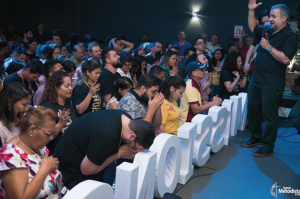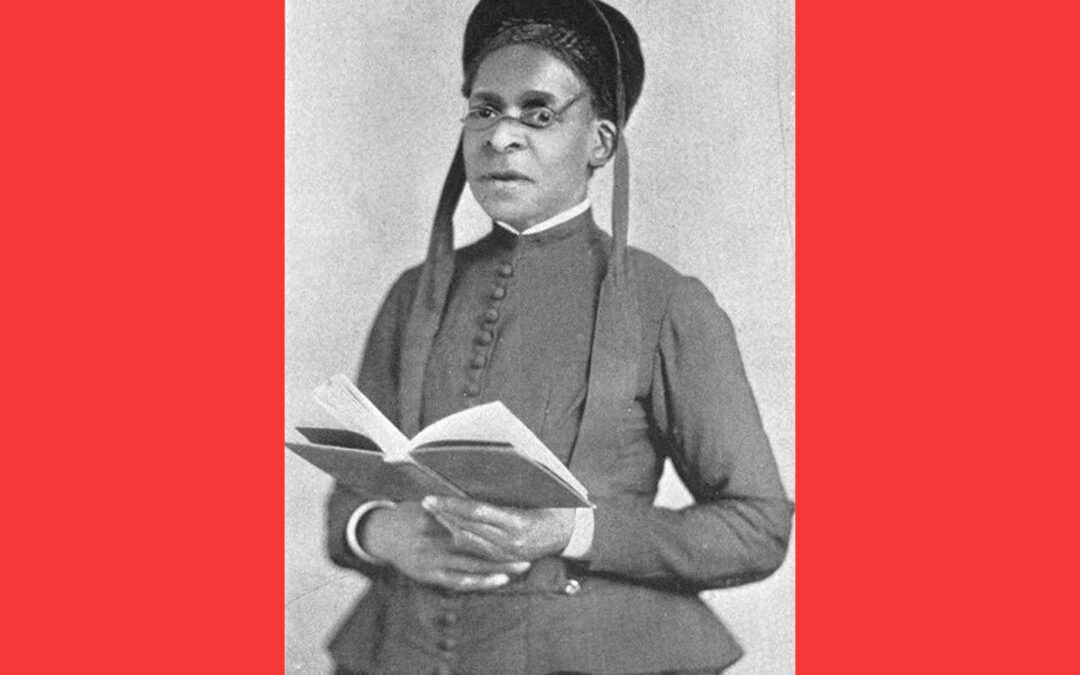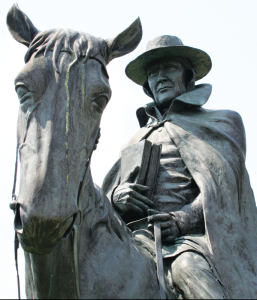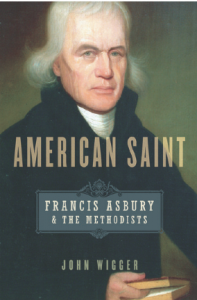
by Good News | Dec 29, 2021 | Magazine Articles, November/December 2021

Photo: Shutterstock.
By Shannon Vowell
I spent much of last week sitting with a beloved family member, watching as he struggled for the next breath. His ankles had swollen to four or five times their normal size, and were the color of eggplants. His belly was also distended; the bruising there was even more vividly hued. Needles and tubes protruded from his arms; a cluster of tubes with caps on them dangled from his neck; a catheter emptied the contents of his bladder into a plastic container that hung bedside. He woke occasionally for disconcertingly mundane conversation – asking for a sip of Ginger Ale, requesting that his foot be more elevated, wondering whether “The Price is Right” was coming on soon. The surreal horror of it overwhelmed me.
“ICU psychosis” is a thing. It refers to a variety of madness that sets in after days on end in a place where nothing changes – incessant light, noise, and urgency interwoven with long spells of acute boredom – ICU psychosis is the logical response to being held captive by a broken body in a physical place of suspended animation.
ICU psychosis is marked initially by the patient’s inability to identify the date, month, year. It progresses from there to the inability to identify family members. It eventually swallows up recall of even personal identity.
What do such nightmarish facts have to do with Advent? Absolutely everything.
The physical brokenness on display in the ICU – the mental brokenness on display in ICU psychosis – these are windows into the unfathomable wonder of the Incarnation.
How so?
Jesus chose to inhabit a body whose potential for brokenness was as complete as that of any ICU patient. The colors of his bruises, the necessity of oxygen in his lungs, the fragility of his heart – Jesus chose these conditions.
And Jesus, Co-Creator of all that is or ever has been, chose to inhabit the physical realm of Creation – where time and space put boundaries on his omnipotence and omnipresence – where he could be subjected to all the suffering specific to creatures who live in time and space. He chose that vulnerability, that limitation, that smallness. Jesus, the Lord of Lords, who existed before the Universe was made, deliberately put himself in position to experience the time-tethered human consciousness that can devolve into ICU psychosis.
We often forget, in the colored-lights-and-hot-cocoa routines of our secularized celebrations, that Advent is about God’s choice to take on flesh – to be born, to live, and to die. The ICU re-orients our eyes to the incomprehensibly lavish affection behind that choice.
Paul spells it out in Philippians 2:5-8 that Christ Jesus, “being in very nature God, did not consider equality with God something to be used to his own advantage; rather, he made himself nothing by taking the very nature of a servant, being made in human likeness. And being found in appearance as a man, he humbled himself by becoming obedient to death – even death on a cross!”
That emptying – that “being made in human likeness” –ultimately found Jesus nailed to a wooden cross, enduring the same physical agonies as the criminals on either side of him even as he also endured the unimaginable and unrepeatable agonies of the cumulative burden of all human sin, conjoined with the unimaginable and unrepeatable agony of separation from his Father.
Jesus chose this.
Chose it for us, out of love for us, out of a love so infinite and holy and perfect that we can never come close to understanding it.
The Incarnation – Advent – Christmas – these are opportunities for remembering not just the beauties of angels in the night sky, but also the blood and sweat and risk of a teenage girl delivering a baby, and the impossible truth that her baby was God.
The Incarnation – Advent – Christmas – these are opportunities for remembering not just the Gift of the Christ-child in the manger, but the infinite costliness of that Gift – and the willingness of Christ-child, of Father, of Holy Spirit, to bear that cost for us.
The Incarnation – Advent – Christmas – these are opportunities for remembering not just the sweet traditions of family gatherings, favorite recipes, and sparkly presents under the tree, but also the Gift of Presence which Immanuel – God-with-us, Jesus! – gives in an ongoing way because of the Incarnation. Because of Christmas I pray that your Advent and Christmas unfold far, far away from the ICU.
But I also pray that your Advent and Christmas will be made richer and more truth-powered as you contemplate the truth about Jesus which the ICU makes clear: Jesus chose to be confined to human flesh. Jesus chose to be confined to time and space. Jesus chose vulnerability, poverty, betrayal, and pain – because He loves you.
Boundlessly.
Excruciatingly.
Eternally.

by Good News | Dec 28, 2021 | Magazine Articles, November/December 2021
 By B.J. Funk –
By B.J. Funk –
Before leaving for a lengthy trip, I drove into the crowded gas station. All of the pumps were filled, so I pulled my car to be second in line. Our cars were facing, head-to-head, because my fuel tank was on the opposite side from hers. No problem. I’ll just wait a bit.
A bit turned into several minutes, and I watched as the young woman continued looking down at her lap. She never looked up.
She’s probably waiting for the one in the passenger seat to return from paying, I thought.
Or maybe she’s counting her change and will get out and go pay soon.
Neither. She continued looking down, and now I had waited a good five minutes. I decided to get out and go knock on her window.
“Hi. I’m wondering if you are finished getting gas if you could pull out so I could pull in,” I said. A smile adorned my face.
She looked up, mirroring my smiling face with her unhappy face. Uh oh.
“I will move as soon as I finish texting,” she said flippantly. “Besides, there are plenty of other gas pumps. Go to one of those.”
I believe she inherited that disgusted look from Adam when he looked at Eve and said, “See what you’ve done! See the price we now have to pay because you took that one piece of fruit?”
The fact that I needed gas seemed somehow my fault!
The other pumps were still full. I walked back to my car, and I have to be honest. I was not thinking sweet cookies, yummy ice cream, and peppermint candy thoughts about her. I was thinking frogs, snakes, alligators, bears, lions, and wolf thoughts. And, it would have been just fine with me if any of those animals had shown up right about now. In her car.
Questions popped in my mind. Should I go ask the store clerk to tell her to move? Should I start honking my horn? Should I…
At that time, grace began to stir inside. Oh no! I really wanted to handle this one without grace.
But grace said, “Pray for her. Think of what she may be going through personally. Understand that her life might be difficult, and she is barely holding on to the little confidence she has left. Perhaps she just had a fight with her husband. Maybe finances are low. Bottom line … she is too overwhelmed with life right now to be nice. Too burdened to be thoughtful.”
I wanted to disagree. “I’ve had a few hurtful things happen myself, Grace. You never saw me acting like that, have you?”
“As a matter of fact, I have.”
Humble Pie had never tasted so salty.
Grace said, “I’ve seen you be pretty selfish, B.J., especially when things didn’t turn out like you wanted. I’ve seen your ego swell when what I wanted to swell was Me in your life. I’ve actually heard your heart thinking thoughts similar to what this young woman is thinking.”
Once again, grace won. I started praying for my twin in the car ahead of me.
Grace, grace, marvelous grace. Thank you for once again coming through to teach me a lesson. Eventually, she pulled out, never acknowledging me. But, if grace is right … and she always is … she had too much on her heart to be nice.
I should know. Twins always think alike.
BJ. Funk is Good News’ long-time devotional columnist and author of It’s A Good Day for Grace, available on Amazon.

by Good News | Dec 28, 2021 | Magazine Articles, November/December 2021
 By Luciano Pereira da Silva –
By Luciano Pereira da Silva –
For the sake of context, allow me to describe my own transformation story. I was born in the interior of Brazil. My family was impoverished and dysfunctional, with problems such as violence, alcohol addiction, and illness. As a child I had no future hopes, only thoughts of death. But the Lord had plans for my life. By his grace, I was invited to participate in a Methodist Youth meeting and my life began to change.
I met Jesus and discovered his mission. I experienced a spiritual call to ministry in a meeting with foreign missionaries. They were part of a group connected to Rick Bonfim Ministries. Pastor Rick is a well known Brazilian Methodist evangelist. Upon meeting this group and experiencing my call to ministry, I wanted to connect my life story with missionaries from abroad.
This desire was not without its challenges, however. Protestant missionaries from the United States and Europe have had many religious and political obstacles in establishing and expanding their mission in South America. They brought much hope to me and many people like me. They helped to build churches, schools and Bible societies; to spread the principles of the gospel; and to introduce the Kingdom of God. That work, which began in the 19th century, continues today. We also know, however, that their approach to the mission has often been problematic.
The idea of empowering indigenous leaders within the mission has proven especially challenging for many missionaries, often due to a lack of confidence in delegating leadership positions to them. Even today, this missionary model has several problems that are still prevalent, especially in traditional Protestant churches. Because of a model that often fails to raise up and equip indigenous leaders, a culture of dependency has been created. The result has been a Latin American church culture that has failed to thrive, grow, and live into its potential.
There is a significant contrast between the historical approach of traditional Protestant denominations and that of more recent Pentecostal movements. Pentecostal churches have arisen and grown exponentially in Latin America during the last century. Much of this growth is because they have a soft system of training indigenous workers, both clergy and laity, and they have demonstrated the ability to respond to the needs of common people.
We know that Latin America and the Caribbean continue to have many economic and political problems. But even with the challenges we can change for the better with the help of fully trained and empowered indigenous leaders. Especially with support for the training and deployment of indigenous Latin American mission leaders, we can make a difference for the advancement of the mission.
The generosity of the New Testament church serves as a prime example. “Let me tell you, my dear family, about the grace which God has given to the Macedonian churches. They have been sorely tested by suffering. But the abundance of grace which was given to them, and the depths of poverty they have endured, have overflowed in a wealth of sincere generosity on their part,” writes Paul. “I bear them witness that of their own accord, up to their ability and even beyond their ability, they begged us eagerly to let them have the privilege of sharing in the work of service for God’s people. They didn’t just do what we had hoped; they gave themselves, first to the Lord, and then to us as God willed it” (2 Corinthians 8:1-5).
The CIEMAL (Council of Methodist Evangelical Churches of Latin America and the Caribbean) seeks to empower potential Kingdom leaders through various training programs. The vision is to mobilize, train, and connect laity, clergy, bishops, and local churches to join Jesus in His mission, with the intention of awakening people to help each other with the gifts and talents that the Holy Spirit has given them.
We desire and envision a relationship with agencies and missionaries abroad as follows: the relationship must be cultivated, but from a vision of interdependence, not dependency. The mission’s agenda should never be imposed by outsiders, but rather be contextualized and mutually shared.

Dozens of Brazilians responded to serve in cross-cultural missions during the Amazonas Missions Conference in Porto Velho, Brazil. Held in March 2019, the event brought together churches from the Amazon Conference of the Methodist Church of Brazil. Shown speaking: the Rev. Luciano Pereira Da Silva. Photo courtesy of the Methodist Church of Brazil.
I believe that this is the moment when we need to mobilize workers and awaken them to engage with God’s mission in the world. The mission belongs to God and he has given us the privilege of participating in it. All God’s people are needed, and not just those from traditional sending nations.
The good news is that there exist some special characteristics of Latinos that can make a difference in the mission: their ability to adapt to any circumstance, to learn other languages and cultures, their enthusiasm, and their passion. I believe with all my heart that God is blazing a new path for global mission and he wants to awaken the Latin people to this passion.
We must concentrate our efforts on mobilizing the people of Latin America and the Caribbean and making them aware of this very strong and fundamental call from God. I know that many young people in our countries can see their lives transformed (like mine was) by the power of the gospel and receive the power of the Holy Spirit to serve God in many ways. May God continue to bless us in this way.
Luciano Pereira da Silva is the Secretary-General for CIEMAL, the Council of Evangelical Methodist Churches of Latin America and the Caribbean. He has served as pastor in the Methodist Church of Brazil since 2002. In 2010 he and his family were sent as missionaries to Peru, where for four years he was the National Director of Discipleship. He currently lives in Panama, Central America, where he serves as a local church pastor and church planter. He has authored four books.
Since 2014, TMS Global has collaborated with CIEMAL in mobilizing Latin Americans in 19 countries for mission and ministry. This is the first of a series of articles provided by TMS Global to platform some important voices from the Global South.

by Good News | Dec 28, 2021 | Magazine Articles, November/December 2021
Julia Foote and the Geography of Witness
By Elizabeth Glass Turner – 2021 –
What do you know of Zanesville, Ohio? History buffs might enjoy its distinct Y-shaped bridge or explore its history as part of the Underground Railroad or recall it for its well-known river and locks. If a spiritual pilgrimage were traced across the tilts and rolls of Ohio’s farms, rivers, and valleys, Methodists might mark a gentle circle around Zanesville. It’s not unique for towns that sprang up across the Midwest to have Methodist fellowships woven through their roots; but those Methodist fellowships in the mid-1800s were not without profound flaws.
In the autobiography of Julia Foote – happily available for download through Asbury Theological Seminary’s First Fruits Press – readers are confronted with this reality. On joining the local Methodist Episcopal church (in the state of New York), her parents, both former slaves, were relegated to seating in one part of the balcony of the local church and could not partake of Holy Communion until the white church members, including the lower class ones, had gone first.
Eventually, Julia Foote would become the first woman ordained a deacon in the AME Zion church, the second woman ordained an elder. Before that, she was an evangelist, traveling and preaching in a number of places, starting before the Civil War. At times, congregational conflict emerged when she visited a town, sometimes because Foote was Black, sometimes because she was a woman. But the testimony of her visit to Zanesville is different.
Before arriving in Zanesville in the early 1850’s, Foote had been in Cincinnati and Columbus, then visited a town called Chillicothe. Her time in Chillicothe was fruitful but not without controversy.
The following excerpts retain Foote’s own original language, a reflection of the time in which she lived:
“In April, 1851, we visited Chillicothe, and had some glorious meetings there. Great crowds attended every night, and the altar was crowded with anxious inquirers. Some of the deacons of the white people’s Baptist church invited me to preach in their church, but I declined to do so, on account of the opposition of the pastor, who was very much set against women’s preaching,” she wrote. “He said so much against it, and against the members who wished me to preach, that they called a church meeting, and I heard that they finally dismissed him. The white Methodists invited me to speak for them, but did not want the colored people to attend the meeting. I would not agree to any such arrangement, and, therefore, I did not speak for them. Prejudice had closed the door of their sanctuary against the colored people of the place, virtually saying: ‘The Gospel shall not be free to all.’ Our benign Master and Saviour said: ‘Go, preach my Gospel to all’” (Julia A. J. Foote, A Brand Plucked from the Fire: An Autobiographical Sketch, First Fruits Press).
Whether or not the good Baptists of Chillicothe today know that their forebears ousted a pastor who objected to a woman evangelist, the Methodists may be unaware that their forebears invited a Black woman to preach – but only if people of color were excluded from the meeting. And yet, in spite of these local controversies, Julia Foote wrote that in that town, “we had some glorious meetings,” and “the altar was crowded.” Like John Wesley, Foote sowed grace outside church buildings, even if she could not sow grace inside church buildings. Like the Apostle Paul, she proclaimed the Gospel to those who would welcome her.
But then, she went to Zanesville. And here, readers see a different move of the Holy Spirit. What was the difference?
“We visited Zanesville, Ohio, laboring for white and colored people. The white Methodists opened their house for the admission of colored people for the first time. Hundreds were turned away at each meeting, unable to get in; and, although the house was so crowded, perfect order prevailed,” Foote wrote in A Brand Plucked. “We also held meetings on the other side of the river. God the Holy Ghost was powerfully manifest in all these meetings. I was the recipient of many mercies, and passed through various exercises. In all of them I could trace the hand of God and claim divine assistance whenever I most needed it. Whatever I needed, by faith I had. Glory! glory!! While God lives, and Jesus sits on his right hand, nothing shall be impossible unto me, if I hold fast faith with a pure conscience.”
Foote labored for any and all for the sake of the Kingdom when she arrived in Zanesville. While there, for the first time, Methodist worship was integrated. So many people came, hundreds had to be turned away. Despite the crowds, there was no controversy or dispute. And – “God the Holy Ghost was powerfully manifest in all these meetings.” There was no segregated worship; the Holy Ghost was powerfully manifest.
This is powerful testimony reverberating down through the soil, through the generations, through the Kingdom. Sitting today in a different part of the state over 150 years later, I read the words of Julia Foote and see the rolling hills of Ohio differently. I’ve been in Cincinnati, and Columbus, and Chillicothe. I’ve read those names on road signs. I’ve seen church buildings in those places. Through her words, I hear the voice of a mother of American Methodism, particularly the holiness movement, calling across the rivers, the years. She was pressed, but not crushed; persecuted, but not abandoned; struck down, but not destroyed. Her eyes too saw this rural landscape in the springtime; heading from Zanesville on to Detroit, she also likely saw Mennonite and Amish farmers along the road. She sowed grace into this landscape before my great-grandmother was born. Before the Wright brothers followed the birds skimming along air currents, Julia Foote learned how to glide on the wind of the Spirit: “whatever I needed, by faith I had.”
Today, in the yard outside my window, irises are blooming that I did not plant; someone else planted, another watered, and I enjoy the deep purple unfurling from the bud. Reading of Foote’s ministry, I am given a window onto the grace planted by faith, the results of which would have shaped the spiritual life of a community for decades. But it does not let me rest on what came before; her labor calls out across the rivers, the years, questioning: how are you tending to what others planted through the Spirit? She endured great hardship to proclaim the Word of God in this landscape. I would not rip out or mow over the irises carefully planted by another; how might I help to care for what she was bold enough to sow? Decades later – and yet not so very long at all – where is the Spirit brooding, full, like a thundercloud full with rain, ready to burst?
 Sister Julia issued this challenge: “Sisters, shall not you and I unite with the heavenly host in the grand chorus? If so, you will not let what man may say or do, keep you from doing the will of the Lord or using the gifts you have for the good of others,” she wrote in A Brand Plucked. “How much easier to bear the reproach of men than to live at a distance from God. Be not kept in bondage by those who say, ‘We suffer not a woman to teach,’ thus quoting Paul’s words, but not rightly applying them. What though we are called to pass through deep waters, so our anchor is cast within the veil, both sure and steadfast?”
Sister Julia issued this challenge: “Sisters, shall not you and I unite with the heavenly host in the grand chorus? If so, you will not let what man may say or do, keep you from doing the will of the Lord or using the gifts you have for the good of others,” she wrote in A Brand Plucked. “How much easier to bear the reproach of men than to live at a distance from God. Be not kept in bondage by those who say, ‘We suffer not a woman to teach,’ thus quoting Paul’s words, but not rightly applying them. What though we are called to pass through deep waters, so our anchor is cast within the veil, both sure and steadfast?”
The gifts you have, for the good of others.
It is the Holy Spirit who transforms history into testimony, the same Spirit who was “powerfully manifest” now bearing down, laboring again. In the original introduction to A Brand Plucked, Thomas K. Doty wrote, “Those of us who heard her preach, last year, at Lodi, where she held the almost breathless attention of five thousand people, by the eloquence of the Holy Ghost, know well where is the hiding of her power.”
What do you know of Zanesville, Ohio? That Julia Foote preached there in the 1850s, sowing grace? That Methodists there rejected segregated worship, joining together, and the Holy Spirit was “powerfully manifest”?
What do you know of the Holy Spirit, today? What do you know of those who planted and watered while God gave the increase, long before you saw the buds?
Sisters and brothers, we do not walk into ministry alone today. Wherever you are, someone has gone ahead, sowing grace ahead of you. If the rivers could speak, they might gossip to you about the ones who went before; who crossed rivers when no plane had yet crossed the sky.
What do you know of Zanesville, Holy Spirit? Hearts there once were soft.
What do you know of the Holy Spirit, Zanesville? Once, the Spirit was powerfully manifest in your midst.
Holy Spirit, where are you brooding now? Give us the grace of readiness..
Elizabeth Glass Turner, a frequent contributor to Good News, is the editor of Wesleyan Accent (www.WesleyanAccent.com). This article is reprinted by permission of Wesleyan Accent.

by Good News | Dec 28, 2021 | Magazine Articles, November/December 2021

“The Sabbath is different from the other six days, because it is the day we stop using our time to gain something for ourselves and return to the fact that our time belongs to God,” writes the Rev. Nako Kellum. Photo by Tyler Lastovich (Pexels).
By Nako Kellum –
Shortly after I bought my first smart phone, I was at Disney World with my family for vacation. When I was standing in line for “It’s a Small World,” I received a text from work, and without thinking, I answered it immediately. Then, a thought came to me, “If I did not have this phone, I could not have been reached, and I would not have responded during my vacation!” That day, I felt like I lost something significant.
With the advance of technology, it is difficult to keep the Sabbath. Instead of going to work and sitting in front of computer, we carry “work” with us, 24/7.
I have to confess that for a long time, I have had “days off,” but I have not practiced Sabbath keeping. According to Eugene Peterson, these two are different things. He calls a day off “a bastard sabbath.” Usually, my days off are filled with different “have-to” errands – grocery shopping, cooking, doing laundry, cleaning, the children’s extra-curricular activities, etc. It was not until recently that I learned about what observing the biblical Sabbath truly means, and how much I need it.
Of course, I knew Sabbath-keeping is one of the Ten Commandments, but I do not think I took it as seriously as the other Commandments. I was careful about not having any other gods or making an idol and even preached about it. I was careful to not use the name of the LORD in vain. I honored my parents, and I took the commandments against murder, adultery, stealing, and coveting seriously. But Sabbath keeping? Not so much. Yet, in the Ten Commandments, it is the only commandment that comes with the reason as to why we have to keep it. “Remember to observe the Sabbath day by keeping it holy … For in six days, the LORD made the heavens, the earth, the sea, and everything in them; but on the seventh day he rested. That is why the LORD blessed the Sabbath day and set it apart as holy” (Exodus 20:8,11, emphasis added).
God established the rhythm of our lives in creation – work for six days and stop on the seventh day. It is based on God’s action in creation, and as his image-bearers, we are to follow him. If we play by our own rhythm instead of God’s, we disrupt the harmony God built into his creation. Maybe that is why we have problems such as stress or burn-out; we are out of sync with his rhythm.
The Sabbath is not just a simple day that we quit working; it is a day of “rest dedicated to the LORD your God” (Exodus 20:10). It is a day we reorient our perspectives on our lives. Sabbath in Hebrew means to “cease” or to “stop.” The Sabbath is different from the other six days, because it is the day we stop using our time to gain something for ourselves and return to the fact that our time belongs to God. It is the day we remind ourselves that we are not God; it is God who runs this universe. It is interesting that in Jewish culture, the Sabbath begins at sundown on Friday and ends at sundown on Saturday. All we must do at sundown is eat and go to bed; the only one who is awake is God. When we wake up, God is already at work. It reminds me that God is the one who takes the initiative, and he is the one who is sustaining the world. My part is to see what he is already doing and participate in his work. It is a day to pay close attention to God, and what he does in this world.
Another aspect of the Sabbath is that it is a day to remind us of who we are – human “beings,” not human “doings.” In Deuteronomy 5:15, after giving the commandment on the Sabbath, Moses says, “Remember that you were once slaves in Egypt, but the LORD your God brought you out with his strong hand and powerful arm. That is why the LORD your God has commanded you to rest on the Sabbath day.” The Israelites came out of slavery, during which time they were treated harshly and had to work seven days a week. They probably felt relief that they had a day that they did not have to work. When we value human beings, including ourselves, in terms of productivity, we lose a bit of our humanity, as God created us to be. He did not create us to be machines, but he created us as “beings” who enjoy being with him and with people. The Sabbath lets us just “be” in his presence and with each other, without worrying about being productive or accomplishing something. This may be one of the most counter-cultural things we can do as Christians now, in a culture where people are valued in terms of how much money they make, or their status, or which school they attended.
God blessed the seventh day of Creation, and he blesses the Sabbath day. Psalm 92 is a song of the Sabbath Day, which starts with giving thanks and praise to God. The Sabbath is a day of celebration and worship, as we give thanks and praise to God for who he is and his work. It is a day to enjoy God’s creation, delighting in the good gifts he has given us, and simply having fun.
To be honest, observing the Sabbath has not been easy. It is difficult for me to keep a full day of Sabbath (which I try to do on Saturday), but let me share a few things I have learned so far:
• Observing the Sabbath is a spiritual discipline. It does not just happen automatically. It takes intentionality just like any other spiritual discipline.
• It takes preparation. If I want to take a break from doing chores, I need to finish them by my Sabbath. It means no more procrastination regarding my work, which means I have to prioritize what I do during the six days.
• I must be careful not to be legalistic about it either. Jesus said, “The Sabbath was made to meet the needs of people, and not people to meet the requirements of the Sabbath.” I have to keep in mind the heart of God behind the Sabbath and see it as a gift and grace from God. There are days I cannot keep 24 hours of Sabbath, and that is okay for now.
• The church runs fine without me, and our family is fine even if the house is not tidy and we eat frozen pizza on paper plates. In other words, I have learned the world runs just fine without me running around, trying to do all my “have-to” errands. It takes away a sense of self-importance and control and it reminds me that God is the one who initiates the work and He’s always at work.
 • God accepts me for who I am, not for what I do. He enjoys being with me and invites me to enjoy just being with Him. He is slowly teaching me not to put my self-worth on how much I have accomplished or how many boxes I checked on my check list.
• God accepts me for who I am, not for what I do. He enjoys being with me and invites me to enjoy just being with Him. He is slowly teaching me not to put my self-worth on how much I have accomplished or how many boxes I checked on my check list.
If you do not keep the Sabbath, I invite you to join me in this journey of Sabbath-keeping. Let us not check texts or emails for a day. Let us just “be” with God and with each other. Let us go outside and put ourselves in his creation that he has called “good.” Let us rest, have fun, and enjoy the good and beautiful gifts God gives us and be thankful.
Nako Kellum is co-pastor in charge at Tarpon Springs First United Methodist Church in Tarpon Springs, Florida. The Rev. Kellum is also a member of the Wesleyan Covenant Association Global Council. This article originally appeared on the Wesleyan Covenant Association website and is reprinted here by permission.

by Good News | Dec 28, 2021 | Magazine Articles, November/December 2021

On September 4, 1771, Francis Asbury left England in order to preach the gospel in America. During his lengthy journey, Asbury asked himself, “Whither am I going? To the New World. What to do? … I am going to live to God, and to bring others so to do.” We celebrate this 250th anniversary of his crossing the Atlantic to share the gospel of Christ. Francis Asbury statue at Asbury Theological Seminary in Wilmore, Kentucky. Good News file photo.
By John Wigger –
Francis Asbury lived one of the most remarkable lives in American history, a life that many have admired but few have envied. The son of an English gardener, he became one of America’s leading religious voices and the person most responsible for shaping American Methodism.
During his 45-year career in America (he died in 1816), he never married or owned much more than he could carry on horseback. He led a wanderer’s life of voluntary poverty and intense introspection.
The church and the nation ultimately disappointed him, but his faith never did. Asbury embodies Methodism’s greatest successes and its most wrenching failures.
Asbury traveled at least 130,000 miles by horse and crossed the Allegheny Mountains some sixty times. For many years he visited nearly every state once a year, and traveled more extensively across the American landscape than probably any other American of his day. He preached more than ten thousand sermons and probably ordained from two thousand to three thousand preachers. He was more widely recognized face to face than any person of his generation, including such national figures as Thomas Jefferson and George Washington. Landlords and tavern keepers knew him on sight in every region, and parents named more than a thousand children after him. People called out his name as he passed by on the road.
Like any good eighteenth- or early nineteenth-century evangelical, Asbury was never satisfied with his own piety or labors. Yet people saw in him an example of single-minded dedication to the gospel that they themselves had never managed to attain, but to which, on their better days, they aspired. In their eyes he was indeed a saint. Though he spent his life traveling, he insisted on riding inexpensive horses and using cheap saddles and riding gear. He ate sparingly and usually got up at 4 or 5 a.m. to pray for an hour in the stillness before dawn. No one believed that Asbury was perfect, and even his most ardent supporters admitted that he made mistakes in running the church. Yet his piety and underlying motivations seemed genuine to almost everyone.
His legacy is not in books and sermons, but in the thousands of preachers whose careers he shaped one conversation at a time, and in the tens of thousands of ordinary believers who saw him up close and took him (in however limited a way) as their guide. Asbury communicated his vision for Methodism in four enduring ways.
1. Asbury had legendary piety and perseverance, rooted in a classically evangelical conversion experience. Piety isn’t a word we use much anymore. It simply refers to devotion to God and serving others, to a desire to “love the Lord thy God with all thy heart, and with all thy soul, and with all thy mind,” and “thy neighbour as thyself.”
Where most Methodists, even most preachers, settled for a serviceable faith, Asbury strove for a life of extraordinary devotion. During his forty-five years in America he essentially lived as a houseguest in thousands of other people’s homes across the land. He lived one of the most transparent lives imaginable, with no private life beyond the confines of his mind. Asbury’s piety brought him respect, even renown, based on sacrifice rather than accumulation of buildings, money, or other trappings of power.
2. Asbury communicated his vision through his ability to connect with ordinary people. As he crisscrossed the nation from year to year, he conversed with countless thousands, demonstrating a gift for building relationships face to face or in small groups. It is remarkable how many of those he met became permanent friends, even after a single conversation. They loved to have him in their homes. Asbury often chided himself for talking too much and too freely, especially late at night. He considered this love of close, often lighthearted, conversation a drain on his piety. In reality it was one of his greatest strengths, allowing him to build deep and lasting relationships and to feel closely the pulse of the church and the nation.
Henry Boehm, who traveled some 25,000 miles with Asbury from 1808 to 1813, recalled that “in private circles he would unbend, and relate amusing incidents and laugh most heartily.” He could also be funny, which enhanced his appeal.
3. Asbury understood and used popular culture. Asbury was remarkably well-informed (the product of his travels and love of conversation) and flexible in keeping up with these changes, but everyone has their limits. Though the American Revolution led to a good deal of persecution of American Methodists, Asbury fretted that its end would produce too much prosperity and thereby dampen Methodist zeal. As long as they were poor, most Methodists agreed with Asbury that wealth was a snare. But as Methodists became generally more prosperous, they became less concerned about the dangers of wealth, much to Asbury’s dismay.
4. Asbury communicated his message through his organization of the Methodist church. He was a brilliant administrator and a keen judge of human motivations. As Asbury crisscrossed the nation year in and year out, he attended to countless administrative details. Yet he never lost sight of the people involved. “I have always taken a pleasure as far as it was in my power, to bring men of merit & standing forward,” he wrote to the preacher Daniel Hitt in 1801.
The system Asbury crafted made it possible to keep tabs on thousands of preachers and lay workers. No merchant of the early nineteenth century could match Asbury’s nationwide network of class leaders, circuit stewards, book stewards, exhorters, local preachers, circuit riders, and presiding elders, or the movement’s system of class meetings, circuit preaching, quarterly meetings, annual conferences, and quadrennial general conferences, all churning out detailed statistical reports to be consolidated and published on a regular basis.
Under Asbury, the typical American itinerant rode a predominantly rural circuit 200 to 500 miles in circumference, typically with twenty-five to thirty preaching appointments per round. He completed the circuit every two to six weeks, with the standard being a four weeks’ circuit of 400 miles. This meant that circuit riders had to travel and preach nearly every day, with only a few days for rest each month.
 There was another component of Asbury’s system that went to the heart of what it meant to be a Methodist, to practice a method: the necessity of a culture of discipline. As individuals and communities, believers had to take it upon themselves to regulate their spiritual lives, to maintain their own spiritual focus. He insisted on upholding the requirement that all members attend class meetings and that love feasts be limited to active members, creating an atmosphere of mutual trust and support. Though there were plenty of disagreements along the way, Methodists succeeded where other religious groups failed largely because they were more disciplined.
There was another component of Asbury’s system that went to the heart of what it meant to be a Methodist, to practice a method: the necessity of a culture of discipline. As individuals and communities, believers had to take it upon themselves to regulate their spiritual lives, to maintain their own spiritual focus. He insisted on upholding the requirement that all members attend class meetings and that love feasts be limited to active members, creating an atmosphere of mutual trust and support. Though there were plenty of disagreements along the way, Methodists succeeded where other religious groups failed largely because they were more disciplined.
The Methodist church grew at an unprecedented rate, rising from a few hundred members in 1771, the year he came to America, to more than two hundred thousand in 1816, the year of his death. Methodism was the largest and most dynamic popular religious movement in America between the Revolution and the Civil War. In 1775, fewer than one out of every eight hundred Americans was a Methodist; by 1812, Methodists numbered one out of every thirty-six Americans.
He believed that true religion embraced the suffering of the poor and did all that was possible to alleviate it. This is why he allowed himself few comforts. He once told Boehm “that the equipment of a Methodist minister consisted of a horse, saddle and bridle, one suit of clothes, a watch, a pocket Bible, and a hymn book. Anything else would be an encumbrance.” Indeed, Asbury rarely owned much more than this. At the same time, he gave away nearly all the money that came his way.
“His charity knew no bounds but the limits of its resources; nor did I ever know him let an object of charity pass without contributing something for their relief,” John Wesley Bond wrote. He recalled that Asbury often gave money to strangers he met on the road whose circumstances seemed dire, especially widows. He had his share of failings, but the love of money wasn’t one of them.
Much of what makes human life so interesting – family, romance, creating an intellectual legacy – were largely absent from Asbury’s life after his arrival in America as a missionary. But Asbury’s life wasn’t flat, revolving as it did around the relationships he formed with other Methodists. Asbury lived his life in public, and the community of Methodist believers spread across the country became his vast extended family. He must be understood in this context or not at all. Like a rock thrown into a pond, his life sent ripples through the Methodist movement to its most distant reaches.
Asbury wasn’t an intellectual, charismatic performer, or autocrat, but his understanding of what it meant to be pious, connected, culturally aware, and effectively organized redefined religious leadership in America.
John Wigger is Professor of History at the University of Missouri. He is the author of PTL: The Rise and Fall of Jim and Tammy Faye Bakker’s Evangelical Empire, Taking Heaven by Storm: Methodism and the Rise of Popular Christianity in America and co-editor, with Nathan Hatch, of Methodism and the Shaping of American Culture. Reprinted with permission from American Saint: Francis Asbury & The Methodists by John Wigger, published by Oxford University Press, Inc. © 2009 Oxford University Press.



 By B.J. Funk –
By B.J. Funk – By Luciano Pereira da Silva –
By Luciano Pereira da Silva – 

 Sister Julia issued this challenge: “Sisters, shall not you and I unite with the heavenly host in the grand chorus? If so, you will not let what man may say or do, keep you from doing the will of the Lord or using the gifts you have for the good of others,” she wrote in A Brand Plucked. “How much easier to bear the reproach of men than to live at a distance from God. Be not kept in bondage by those who say, ‘We suffer not a woman to teach,’ thus quoting Paul’s words, but not rightly applying them. What though we are called to pass through deep waters, so our anchor is cast within the veil, both sure and steadfast?”
Sister Julia issued this challenge: “Sisters, shall not you and I unite with the heavenly host in the grand chorus? If so, you will not let what man may say or do, keep you from doing the will of the Lord or using the gifts you have for the good of others,” she wrote in A Brand Plucked. “How much easier to bear the reproach of men than to live at a distance from God. Be not kept in bondage by those who say, ‘We suffer not a woman to teach,’ thus quoting Paul’s words, but not rightly applying them. What though we are called to pass through deep waters, so our anchor is cast within the veil, both sure and steadfast?”
 • God accepts me for who I am, not for what I do. He enjoys being with me and invites me to enjoy just being with Him. He is slowly teaching me not to put my self-worth on how much I have accomplished or how many boxes I checked on my check list.
• God accepts me for who I am, not for what I do. He enjoys being with me and invites me to enjoy just being with Him. He is slowly teaching me not to put my self-worth on how much I have accomplished or how many boxes I checked on my check list.
 There was another component of Asbury’s system that went to the heart of what it meant to be a Methodist, to practice a method: the necessity of a culture of discipline. As individuals and communities, believers had to take it upon themselves to regulate their spiritual lives, to maintain their own spiritual focus. He insisted on upholding the requirement that all members attend class meetings and that love feasts be limited to active members, creating an atmosphere of mutual trust and support. Though there were plenty of disagreements along the way, Methodists succeeded where other religious groups failed largely because they were more disciplined.
There was another component of Asbury’s system that went to the heart of what it meant to be a Methodist, to practice a method: the necessity of a culture of discipline. As individuals and communities, believers had to take it upon themselves to regulate their spiritual lives, to maintain their own spiritual focus. He insisted on upholding the requirement that all members attend class meetings and that love feasts be limited to active members, creating an atmosphere of mutual trust and support. Though there were plenty of disagreements along the way, Methodists succeeded where other religious groups failed largely because they were more disciplined.